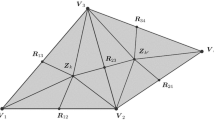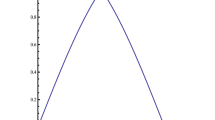Abstract
Isoparametric quadrilateral elements are widely used in the finite element method. However, they have a disadvantage of accuracy loss when elements are distorted. Spline functions have properties of simpleness and conformality. A 17-node quadrilateral element has been developed using the bivariate quartic spline interpolation basis and the triangular area coordinates, which can exactly model the quartic displacement fields. Some appropriate examples are employed to illustrate that the element possesses high precision and is insensitive to mesh distortions.
Similar content being viewed by others
References
Zienkiewicz, O. C. and Taylor, R. L. The Finite Element Method, 5th Ed., Elsevier Pte Ltd., Singapore (2005)
Lee, N. S. and Bathe, K. J. Effects of element distortion on the performance of isoparametric elements. Int. J. Numer. Methods Engrg. 36(20), 3553–3576 (1993)
Long, Y. Q., Li, J. X., Long, Z. F., and Cen, S. Area coordinates used in quadrilateral elements. Commun. Numer. Methods Engrg. 15(8), 533–545 (1999)
Cen, S., Chen, X. M., and Fu, X. R. Quadrilateral membrane element family formulated by the quadrilateral area coordinate method. Comput. Methods Appl. Mech. Engrg. 196(41–44), 4337–4353 (2007)
Li, Y. D. and Chen, W. J. Refined nonconforming 8-node plane elements. Chinese J. Comput. Mech. 14(3), 276–285 (1997)
Li, C. J. and Wang, R. H. A new 8-node quadrilateral spline finite element. J. Comput. Appl. Math. 195(1–2), 54–65 (2006)
Chen, J., Li, C. J., and Chen, W. J. Area coordinates and B-net method for quadrilateral spline elements (in Chinese). Chinese J. Theory Appl. Mech., in press.
Chen, J., Li, C. J., and Chen, W. J. A new method of quadrilateral elements by area coordinates interpolation (in Chinese). Engineering Mechanics, in press.
Rathod, H. T. and Kilari, S. General complete Lagrange family for the cube in finite element interpolations. Comput. Methods Appl. Mech. Engrg. 181(1–3), 295–344 (2000)
Ho, S. P. and Yeh, Y. L. The use of 2D enriched elements with bubble functions for finite element analysis. Computers and Structures 84(29–30), 2081–209 (2006)
Wang, R. H. The structural characterization and interpolation for multivariate splines (in Chinese). Acta Math. Sinica 18(2), 91–106 (1975)
Wang, R. H. Multivariate Spline Functions and Their Applications, Science Press/Kluwer Academic Publishers, Beijing/New York/Dordrecht/Boston/London (2001)
Farin, G. Triangular Bernstein-Bézier patches. Computer Aided Geometric Design 3(2), 83–127 (1986)
Author information
Authors and Affiliations
Corresponding author
Additional information
Communicated by Hong-qing ZHANG
Project supported by the Natural Science Foundation of China China (Nos. 60533060, 10672032, and 10726067) and the Science Foundation of Dalian University of Technology (No. SFDUT07001)
Rights and permissions
About this article
Cite this article
Chen, J., Li, Cj. & Chen, Wj. A 17-node quadrilateral spline finite element using the triangular area coordinates. Appl. Math. Mech.-Engl. Ed. 31, 125–134 (2010). https://doi.org/10.1007/s10483-010-0113-1
Received:
Revised:
Published:
Issue Date:
DOI: https://doi.org/10.1007/s10483-010-0113-1
Key words
- 17-node quadrilateral element
- bivariate spline interpolation basis
- triangular area coordinates
- B-net method
- fourth-order completeness




